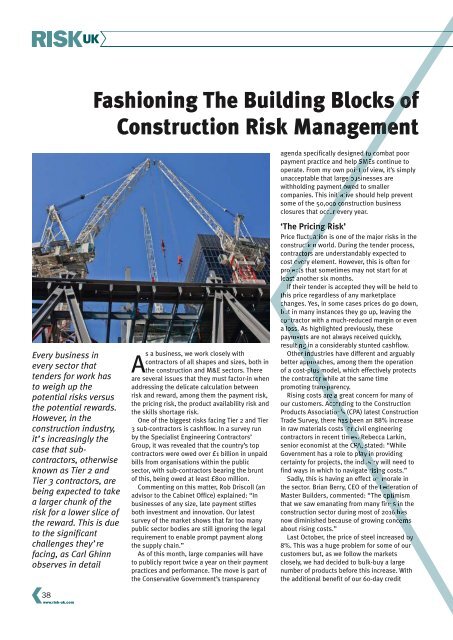RiskUKApril2017
Create successful ePaper yourself
Turn your PDF publications into a flip-book with our unique Google optimized e-Paper software.
Fashioning The Building Blocks of<br />
Construction Risk Management<br />
agenda specifically designed to combat poor<br />
payment practice and help SMEs continue to<br />
operate. From my own point of view, it’s simply<br />
unacceptable that large businesses are<br />
withholding payment owed to smaller<br />
companies. This initiative should help prevent<br />
some of the 50,000 construction business<br />
closures that occur every year.<br />
Every business in<br />
every sector that<br />
tenders for work has<br />
to weigh up the<br />
potential risks versus<br />
the potential rewards.<br />
However, in the<br />
construction industry,<br />
it’s increasingly the<br />
case that subcontractors,<br />
otherwise<br />
known as Tier 2 and<br />
Tier 3 contractors, are<br />
being expected to take<br />
a larger chunk of the<br />
risk for a lower slice of<br />
the reward. This is due<br />
to the significant<br />
challenges they’re<br />
facing, as Carl Ghinn<br />
observes in detail<br />
As a business, we work closely with<br />
contractors of all shapes and sizes, both in<br />
the construction and M&E sectors. There<br />
are several issues that they must factor-in when<br />
addressing the delicate calculation between<br />
risk and reward, among them the payment risk,<br />
the pricing risk, the product availability risk and<br />
the skills shortage risk.<br />
One of the biggest risks facing Tier 2 and Tier<br />
3 sub-contractors is cashflow. In a survey run<br />
by the Specialist Engineering Contractors’<br />
Group, it was revealed that the country’s top<br />
contractors were owed over £1 billion in unpaid<br />
bills from organisations within the public<br />
sector, with sub-contractors bearing the brunt<br />
of this, being owed at least £800 million.<br />
Commenting on this matter, Rob Driscoll (an<br />
advisor to the Cabinet Office) explained: “In<br />
businesses of any size, late payment stifles<br />
both investment and innovation. Our latest<br />
survey of the market shows that far too many<br />
public sector bodies are still ignoring the legal<br />
requirement to enable prompt payment along<br />
the supply chain.”<br />
As of this month, large companies will have<br />
to publicly report twice a year on their payment<br />
practices and performance. The move is part of<br />
the Conservative Government’s transparency<br />
‘The Pricing Risk’<br />
Price fluctuation is one of the major risks in the<br />
construction world. During the tender process,<br />
contractors are understandably expected to<br />
cost every element. However, this is often for<br />
projects that sometimes may not start for at<br />
least another six months.<br />
If their tender is accepted they will be held to<br />
this price regardless of any marketplace<br />
changes. Yes, in some cases prices do go down,<br />
but in many instances they go up, leaving the<br />
contractor with a much-reduced margin or even<br />
a loss. As highlighted previously, these<br />
payments are not always received quickly,<br />
resulting in a considerably stunted cashflow.<br />
Other industries have different and arguably<br />
better approaches, among them the operation<br />
of a cost-plus model, which effectively protects<br />
the contractor while at the same time<br />
promoting transparency.<br />
Rising costs are a great concern for many of<br />
our customers. According to the Construction<br />
Products Association’s (CPA) latest Construction<br />
Trade Survey, there has been an 88% increase<br />
in raw materials costs for civil engineering<br />
contractors in recent times. Rebecca Larkin,<br />
senior economist at the CPA, stated: “While<br />
Government has a role to play in providing<br />
certainty for projects, the industry will need to<br />
find ways in which to navigate rising costs.”<br />
Sadly, this is having an effect on morale in<br />
the sector. Brian Berry, CEO of the Federation of<br />
Master Builders, commented: “The optimism<br />
that we saw emanating from many firms in the<br />
construction sector during most of 2016 has<br />
now diminished because of growing concerns<br />
about rising costs.”<br />
Last October, the price of steel increased by<br />
8%. This was a huge problem for some of our<br />
customers but, as we follow the markets<br />
closely, we had decided to bulk-buy a large<br />
number of products before this increase. With<br />
the additional benefit of our 60-day credit<br />
38<br />
www.risk-uk.com

















